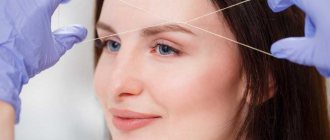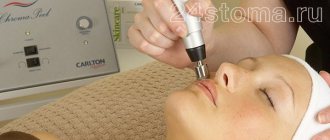Symptoms of atheroma
For a long time, the epidermal cyst may not appear visually. The formation under the skin grows slowly: the process can take a year or more. In this case, a tumor is formed under the skin, in which a secretion consisting of lipid, cholesterol and dead epithelial cells accumulates. The size of the capsule (wen) varies greatly - from a few millimeters to a 5-7 cm diameter.
As a rule, a person notices visual symptoms of atheroma on any or several areas of the face. What does a subcutaneous pathological neoplasm look like? Facial atheroma is characterized by:
- dense structure, which is determined by palpation;
- mobility of the skin over the formation, inability to form a fold in this area;
- the cyst on the face under the skin has an even round shape (resembles a soft ball);
- the epidermis in the tumor area does not differ in color/structure;
- simple atheroma on the cheek or elsewhere on the face does not cause pain;
- the neoplasm is prone to suppuration and inflammation, and these processes are painful and stimulate an increase in skin temperature in the area of the wen;
- a purulent sebaceous gland cyst on the face looks like an abscess (swollen neoplasm with white contents)
Classification, types of sebaceous cysts
The classification of atheromas in medicine is based on the characteristics of the formation of tumor-like formations, their localization, morphological characteristics, the nature of the contents, and histology. According to the mechanism of origin, wen are: congenital; acquired. Secondary fatty deposits include dermoids, steacytomas, and sebaceous cysts in children.
Epidermal cysts, as already noted, form on any part of the body, but most often they are detected in areas that are rich in sebaceous glands.
A sebaceous gland cyst occurs: on the face (T-zone, scalp, forehead, cheeks, lips, eyelids, behind the ear); on the side of the neck; in the groin area, armpits, femoral area (back of the thigh); on the genitals (in men, on the penis, on the testicles, on the scrotum, on the pubis, and in women, the labia and vaginal area are affected); on the back, chest, stomach, shoulders.
Also found in patients is atheroma of the perineum, atheroma of the lacrimal caruncle. In rare cases, cysts form on women's breasts. As a rule, atheroma forms on the nipple. A skin wen can form on the finger. Sometimes they are detected in the spinal cord, in the spine area. Atheroma also forms on the leg.
It is extremely rare for atheroma to occur on the arm; the lower back may be affected. In men, atheroma develops on the penis, testicles, in the groin area, and on the pubis. A large wen requires immediate treatment due to the likelihood of inflammation. According to histology and morphological characteristics, epidermal cystic formations are classified into:
- Sebaceous;
- Dermoid;
- Retention;
- Atheromatosis;
- Trichellemal;
- Steacytoma.
Moreover, all sebaceous gland cysts have the same development mechanism, identical signs and symptoms. This variety is of interest to a dermatologist only for scientific purposes.
Source: vseokiste.ru
Causes of atheroma
The only cause of the disease is blockage of the sebaceous gland on the face due to increased density or impaired outflow of sebum. Different conditions can provoke this process. Such factors are divided into internal and external, the latter including:
- bad ecology;
- heat;
- work in highly polluted conditions;
- use of oil-based cosmetics.
Internal causes of atheroma are:
- oily seborrhea;
- bacterial growth on the face (insufficient skin hygiene);
- hyperhidrosis;
- heredity;
- acne;
- impaired metabolic processes;
- hormone imbalance.
In men, a factor provoking the disease may be an increased amount of testosterone produced and irregular shaving of the beard/mustache. In newborn babies, a cyst on the cheek, as a rule, indicates the presence of maternal hormones. Doctors often associate the appearance of oily warts with the effect of cosmetics with a thick texture on the skin (as a rule, these are oil-based products that clog pores).
- Hair polishing machine - how to choose. Hair polishing with a machine in the salon and at home
- Essentuki 17 – mineral water
- Catering - what kind of service is it? How does an off-site restaurant work for organizing banquets and buffets?
Atheroma in a child
Benign formations on the face are more common during puberty, when adolescents begin puberty. However, experts sometimes diagnose a tumor in small children, including newborns. Atheroma in a child of this age is provoked by the accumulation of fatty secretions, as a result of which the gland duct is clogged. Possible causes of pathology in children may be:
- increased sweating;
- insufficient skin hygiene;
- wearing clothes that are too warm (overheating of the body) or things made of synthetic materials;
- changes at the hormonal level.
Atheroma can occur due to improper functioning of the endocrine system. In addition, children with excess weight, acne and acne are predisposed to pathology. The disease in a newborn indicates defects during the intrauterine formation of the epidermis. The reason for this anomaly is unknown, but some experts associate it with the diet and lifestyle of the woman bearing the fetus.
Localization Features
Most often, formations on the face occur in the forehead, on the cheeks, on the eyelid, and on the wings of the nose. Each localization has its own characteristics:
- Atheroma on the forehead almost always appears in the place where hair growth begins. The forehead is affected by atheromatosis, as it has a large number of sebaceous glands and hair follicles in the area where hair growth begins. Often a cyst occurs on the eyebrow, since there are also hair follicles there, and next to them there are sebaceous ducts.
- Atheroma of the cheek can be caused by improper skin care, hormonal imbalance, and complicated seborrheic dermatitis.
- A cyst in the eye area (on the lower or upper eyelid), as a rule, does not grow to a large size. The upper eyelid is most often affected, as it has more sebaceous glands. The formation does not affect visual function, but often becomes inflamed and suppurates.
- Epidermoid cyst of the nose occurs as a complication of seborrheic dermatitis or acne. It is also possible that a cystic formation may appear due to hormonal imbalances.
Any of these localizations is open to prying eyes, so removal must be carried out using a method that does not leave scars.
Can atheroma resolve on its own?
In rare cases, the neoplasm may disappear without surgical intervention, but you should not hope that the atheroma will resolve on its own. If your doctor advises you to remove the tumor, you should listen to him. A tumor under the skin can be removed in one of three ways: radio wave, surgical excision or laser. Getting rid of a tumor is easy: to reduce the risk of skin damage and scarring, it is better to choose a laser or radio wave method. Relapse after treatment is extremely unlikely - the tumor reoccurs in only 3% of cases.
Treatment of atheroma
Before starting treatment for the disease, atheroma is diagnosed, which consists of a visual examination of the patient and palpation of the tumor. To accurately determine the nature of the tumor, histology (analysis under a microscope) is done. This event makes it possible to establish the presence of atheroma under the skin even when visually it is practically indistinguishable. Gradually, the volume of contents in the cyst increases, which causes the growth of a tumor under the skin.
If you do not begin timely treatment of atheroma, the tumor will become large and can rupture, resulting in tissue infection. To avoid such consequences, it is important to resort to such a treatment measure as surgical removal of the atheroma. Conservative (use of drugs) and traditional methods of treating a tumor are powerless in this case, so cleansing the cyst cavity is carried out by resection, that is, the tumor is removed along with the capsule.
Treatment of atheroma without surgery
If you treat the disease without surgery, you should not expect a quick effect. In addition, only a few achieve positive results using traditional methods and the use of medications, while the condition of the tumor under the skin continues to worsen. If you try to open the capsule yourself, there is a high risk of developing sepsis, since it is impossible to thoroughly clean the cyst at home.
Treatment of atheroma without surgery is highly not recommended, however, if the tumor has ruptured on its own, you need to carefully wipe the wound with a sterile cotton pad, cover it with a bactericidal plaster and consult a doctor (dermatologist or surgeon). The specialist will clean the wound cavity, preventing suppuration or relapse of atheroma. Only surgery can guarantee with almost 100% probability that the tumor will not re-form under the skin.
- Cork board on the wall
- Nano SIM card for smartphone. How to cut a regular or micro SIM card for nano SIM format
- Salad with pine nuts: recipes with photos
Laser removal of atheroma: how the operation works, contraindications and reviews
Laser removal of atheroma is a modern solution to this problem. An operation of this kind takes a minimum of time, does not cause scars and does not require complex rehabilitation. In addition, its implementation almost completely reduces the risk of tumor re-formation due to the sealing of blood vessels.
The nature of athromy formation
Atheroma is a benign tumor. Most often it forms on the head, neck and groin area, that is, on areas of the skin covered with hair, and less often appears on other areas of the face or body. The reason for the formation of atheroma is blockage of the sebaceous gland and the onset of inflammatory processes in it.
It is quite easy to recognize a tumor of this kind: when you press under the skin, you feel a hard capsule containing liquid inside.
Initially small in size, in the absence of treatment it quickly increases (individual specimens resemble a chicken egg).
The formation does not cause pain, and the skin over it does not change in structure (in half of the cases, in the presence of pus, its color changes and cyanosis appears).
The need for treatment and its types
Treatment and removal of atheroma is mandatory. Despite its initially benign nature, it can pose a health threat. It is expressed as follows:
- suppuration;
- the appearance of an unpleasant odor;
- breakthrough of the contents of atheroma and formation of ulcers;
- degeneration of a tumor from benign to malignant.
Treatment of atheroma is carried out by removing it. It is carried out exclusively in a hospital setting; manipulations carried out independently lead to complications and wound infection.
Modern aesthetic medicine practices tumor removal by surgery, laser or radio waves. The laser is considered the most advanced. In its pure form, it is used when the size of the atheroma is less than 5 mm in diameter; in all other cases, complex laser and surgical treatment is practiced.
Preparation for the procedure
Laser or laser-surgical intervention requires certain preparation. In particular, 2 - 3 days before surgery you should give up alcoholic beverages, smoking, foods and medications that thin the blood. It is also recommended to first take tests for HIV, syphilis, hepatitis markers and visit a dermatologist to confirm the diagnosis.
Operation stages
Laser removal of atheroma is carried out under local anesthesia and takes 1 - 1.5 hours. The operation involves the following mandatory steps:
- antiseptic treatment and pain relief;
- cutting the skin with a laser beam;
- evaporation of a capsule with liquid contents;
- treatment of the remaining cavity, sealing of vessels, and in rare cases, suturing.
Surgery to remove atheroma with a laser
If the atheroma is of a significant size, the operation is performed both surgically and using a laser. In this situation, manipulations are built according to the following algorithm:
- antiseptic skin treatment;
- general anesthesia;
- cutting the skin with a laser beam;
- mechanical removal of the capsule;
- treatment of the cavity with a laser beam;
- suturing.
The rehabilitation period after the procedure is determined by the type of intervention and anesthesia used. Immediately after the operation, a hole is formed at the site of the atheroma, which is completely healed within 2 - 3 weeks.
Removed atheroma
Contraindications
Laser removal of atheroma belongs to the category of minimally invasive and safe procedures. However, before conducting a session, experienced surgeons always clarify the patient’s possible contraindications, which include:
- pregnancy;
- diabetes;
- inflammatory processes on the skin at the location of the atheroma;
- fresh tan (obtained less than 2 weeks before the procedure);
- AIDS;
- oncology;
- individual intolerance to laser radiation.
At the discretion of the doctor, the list of contraindications may be expanded.
Advantages and disadvantages
Most patients note the following advantages of such an operation:
- No pain or discomfort during the procedure.
- No side effects or complications.
- Eliminating the risk of re-inflammation by sealing vessels with a laser beam.
- Contactless manipulation.
It should be noted that this type of surgery is not allowed for all patients. If the atheroma has reached a diameter of more than 2 centimeters, laser is strictly contraindicated.
Price
The price of laser tumor removal consists of several factors. At the first stage, you will have to pay for a consultation with a surgeon, about 1000 rubles, and at the second stage - the manipulations themselves.
Their cost depends on the experience of the surgeon, the size of the tumor, the type of anesthesia and the need for additional services. At the initial stage, removal of atheroma will cost approximately 3,000 - 4,000 rubles.
operations to remove atheroma with a laser (operation starts at 1:28)
Laser atheroma removal is a surgical procedure to remove a benign tumor caused by blockage and inflammation in the sebaceous gland. It is carried out in small sizes, is a non-contact and safe method that does not cause complications or scars. Rehabilitation after such an operation takes only a few days and requires special care for the problem area.
Source: https://okosmetologii.ru/defekty-kozhi/udalenie-ateromy-lazerom.html
Surgical methods
If atheroma has formed on the face of a small child (under 7 years old), then the only suitable treatment method is to remove the capsule with a scalpel, laser or radio waves under general anesthesia. In adults, this procedure is performed under local anesthesia. Unlike classic excision with a scalpel, other methods of surgical intervention do not leave visible marks on the skin and minimally injure blood vessels. In addition, laser and radio wave procedures eliminate the need for postoperative measures.
Removal of atheroma on the face with laser
The method is indicated for small tumors without tissue inflammation. Removing atheroma on the face with a laser leaves virtually no scars or scars and does not disturb the subcutaneous microflora. The technique belongs to the bloodless category, and the wounds left after the operation heal quickly. The average duration of the procedure is 20 minutes. If atheroma is removed from the scalp, the patient does not need to pre-shave. The laser treatment method almost completely eliminates the likelihood of relapses.
Atheroma after removal
After excision of a large tumor, the wounds are sutured, and the sutures are removed after about a week (with normal healing process). After removal, atheroma should be treated daily with an antiseptic solution such as Betadine. In addition, in the first few days the wound site should not be wetted. Dressings after surgery are carried out if the source of the disease is in the area of clothing friction. Until the wound is completely healed, it is recommended to treat the skin with Levomekol and Vishnevsky balm.
Diagnostics
Like most skin diseases, atheroma is diagnosed by a dermatologist, but the diagnosis can also be made by a physician and surgeon. It is difficult to independently determine the type of formation, since atheroma is often mistaken for a neoplasm called lipoma. An epidermal cyst is denser to the touch and adheres to the skin, unlike a lipoma.
There are no specific diagnostic methods. To determine the type of tumor, the doctor only needs to conduct a visual examination and palpation. If the diagnosis is confirmed, the patient is referred to a surgeon for removal of the cystic formation.
Treatment of atheroma with folk remedies
Therapy of a neoplasm using non-traditional methods can be carried out only if the symptoms of the disease are not pronounced. At the same time, the most effective are considered to be rubbings, compresses and ointments that are prepared independently at home. Treatment of atheroma with folk remedies may include:
- Ointment for swelling on the skin of the face with burdock. Mix the plant, ground using a meat grinder, with pork fat, leave the mixture in the dark for 3 days. Lubricate the atheroma with the resulting product 1-3 times daily.
- Onions against neoplasms (wen) of skin water. You can reduce the swelling like this: mix the same amount of baked onions with laundry soap, after grinding the ingredients. Apply the mixture to the atheroma, covering the skin with a sterile bandage on top. Change the compress twice a day.
- Lamb fat for adipose tumor. Melt the product and rub it into the affected area of the skin until completely absorbed. Continue using fat until the symptoms of the skin disease decrease.
ethnoscience
Treatment with folk remedies for atheroma can begin immediately after its appearance.
Do not delay starting treatment. To achieve the effect, lamb fat is used in folk medicine. The first method: you need to melt the fat, then cool it to room temperature and rub it into sore spots on the skin. Second method: chop the garlic, add sunflower oil to it. Then mix it all until you get a homogeneous paste. Rub the resulting mixture into problem areas on your body, while not forgetting to massage them. Carry out this procedure until the wen goes away. The main goal of these methods is to draw the contents of the cyst out. Treatment with folk remedies for atheroma gives a positive result. If the methods described above did not help you, do not despair. There are several other methods with which people have been able to get rid of this disease once and for all.
The most important cause of atheroma is slagging of the body. Therefore, in folk medicine it is advised to take herbal teas that will cleanse your body of toxins. You can also try applying films from domestic chicken eggs to the wen. Soon after this procedure, there may be redness and swelling of these areas of the skin.
But don’t worry, as this is a temporary phenomenon and everything will pass in a day. This procedure is carried out until the wen disappears completely. Another effective method for treating atheroma is the use of silver objects. You can attach a silver cross or anything else made of silver and attach it to the sore spot.
This method should be treated for four weeks until the wen resolves. Also, it is not dry leaves that help, but only fresh leaves of coltsfoot, which are fixed to the surface of the cyst with a plaster or bandage and are not removed during the day.
Then they are replaced with fresh ones. After 7-8 days, treatment should help. Many have been helped by the use of Vishnevsky ointment, which has regenerating properties. Apply a gauze bandage soaked in this ointment to problem areas and keep it on for a long time without removing it. A few hours later, see if the contents in the wen have “disappeared”.
If the effect has not yet occurred, repeat this procedure again. Try this method, it has helped many people. As you can see, there are many methods of treating this disease with folk remedies. However, all of them are effective provided that treatment is started at an early stage of the development of the wen.
But how to treat atheroma if it is in an advanced state and causes pain? In such cases, do not self-medicate under any circumstances. Consult a doctor as soon as possible to prevent inflammation and suppuration inside the capsule.
When atheroma becomes inflamed, swelling, pain, and fever appear. Treatment in such cases is carried out only through surgery. Purulent atheroma can break out.
Removal of atheroma is performed on an outpatient basis under local anesthesia, so the patient can return home the same day. If the patient has atheroma on the head, then it is not necessary to shave off the hair when removing it.
Source: tvoelechenie.ru
Prevention of atheroma on the face
Neoplasms arise due to a violation of the outflow of sebum, which occurs due to blockage of pores, therefore the prevention of atheroma on the face should be based on regular cosmetic procedures for cleansing the skin. These include:
- visiting the sauna;
- steam baths;
- cleansing masks;
- massages.
To reduce facial skin oiliness, you should use special tonics and cleansers. In addition, preventing the development of tumors on the skin of the face should include proper, balanced nutrition. So, with high fat content of the skin, you need to exclude fatty and carbohydrate-rich foods from your diet. If the tumor recurs after removal of the tumor, you should definitely contact an endocrinologist who will help determine the causes of the disease.
Prognosis and prevention
Although the epidermoid cyst has a benign course, therapy cannot be avoided, because without treatment there is a risk of developing an inflammatory process and suppuration. Purulent contents can enter the bloodstream, which is fraught with consequences. After cutting out the atheroma with a scalpel, it often recurs; when removed with a laser or radio waves, a complete recovery is observed in all patients.
As a preventative measure, it is necessary to eliminate all risk factors. First of all, you need to maintain facial skin hygiene - wash off makeup at night, wash thoroughly, use scrubs and skin cleansers. Steam baths will help remove dead skin cells from the surface of the face. Metabolic processes can be normalized with the help of a balanced diet and taking vitamins A, B, C, E.










